Managing Change: HRD Strategies for Sustainable Business Performance
VerifiedAdded on 2023/01/13
|10
|2222
|54
Report
AI Summary
This report delves into change management processes within the context of ASDA, a UK supermarket retailer. It explores change management theories, processes, and models, focusing on their application to deliver sustainable business performance. The report examines the role of change management in aligning future skills and capabilities with business strategy, emphasizing the importance of convincing and reward power in motivating employees and driving organizational change. Furthermore, it analyzes factors influencing the development of HRD strategies, including external factors such as government regulations, economic conditions, social trends, and technological advancements. The report concludes by highlighting the significance of HR in managing change and its impact on delivering sustainable business performance and aligning strategies with corporate goals.
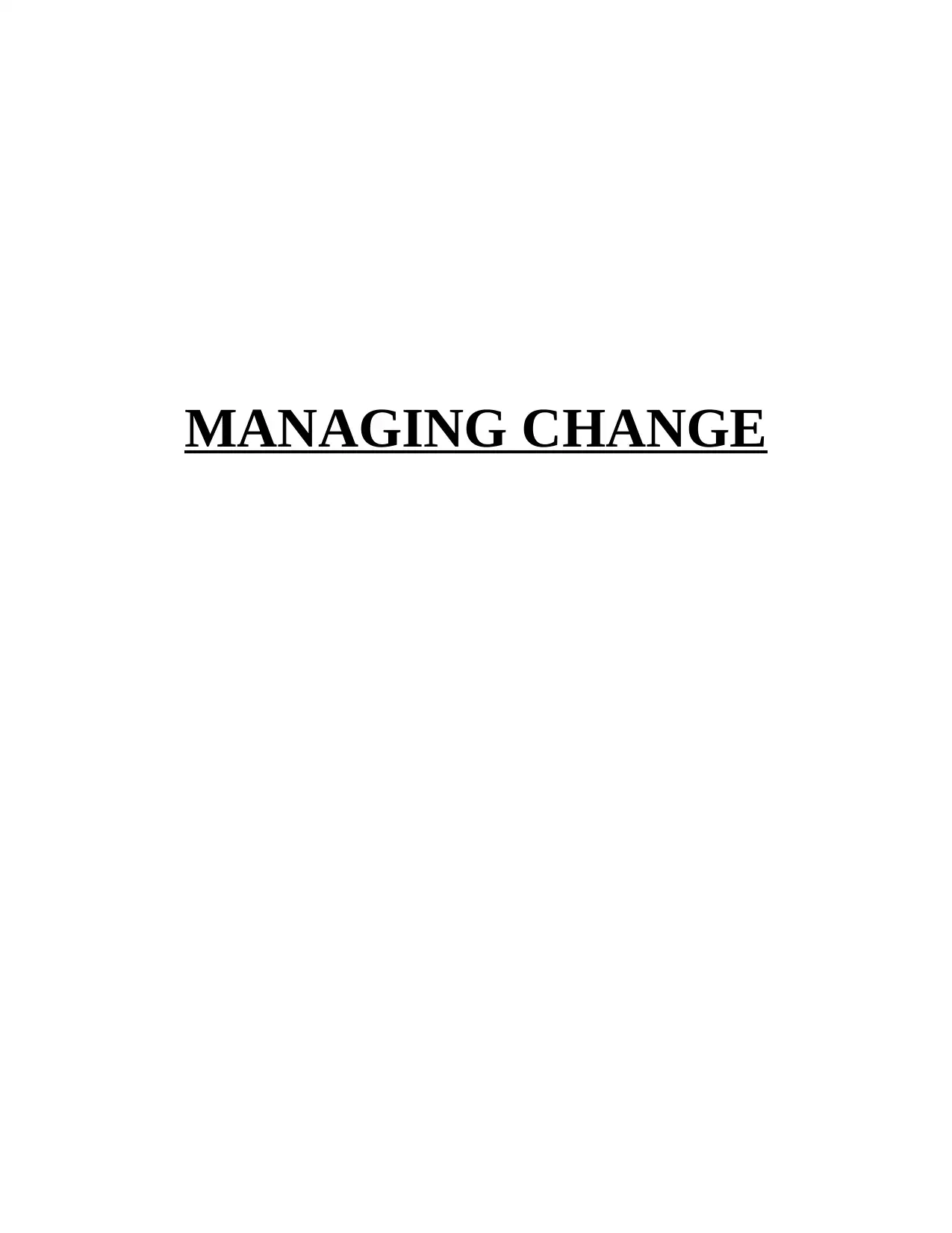
MANAGING CHANGE
Paraphrase This Document
Need a fresh take? Get an instant paraphrase of this document with our AI Paraphraser
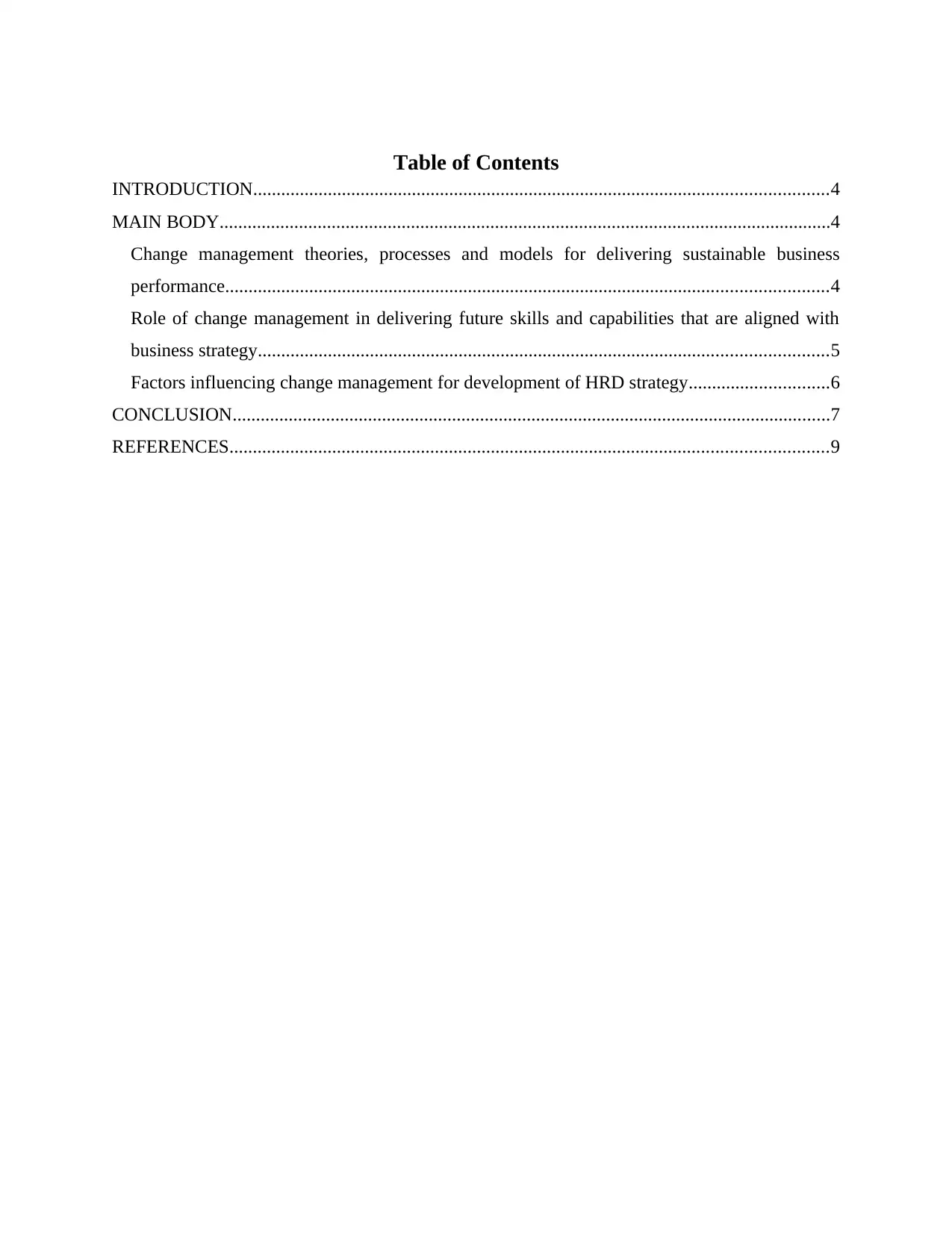
Table of Contents
INTRODUCTION...........................................................................................................................4
MAIN BODY...................................................................................................................................4
Change management theories, processes and models for delivering sustainable business
performance.................................................................................................................................4
Role of change management in delivering future skills and capabilities that are aligned with
business strategy..........................................................................................................................5
Factors influencing change management for development of HRD strategy..............................6
CONCLUSION................................................................................................................................7
REFERENCES................................................................................................................................9
INTRODUCTION...........................................................................................................................4
MAIN BODY...................................................................................................................................4
Change management theories, processes and models for delivering sustainable business
performance.................................................................................................................................4
Role of change management in delivering future skills and capabilities that are aligned with
business strategy..........................................................................................................................5
Factors influencing change management for development of HRD strategy..............................6
CONCLUSION................................................................................................................................7
REFERENCES................................................................................................................................9
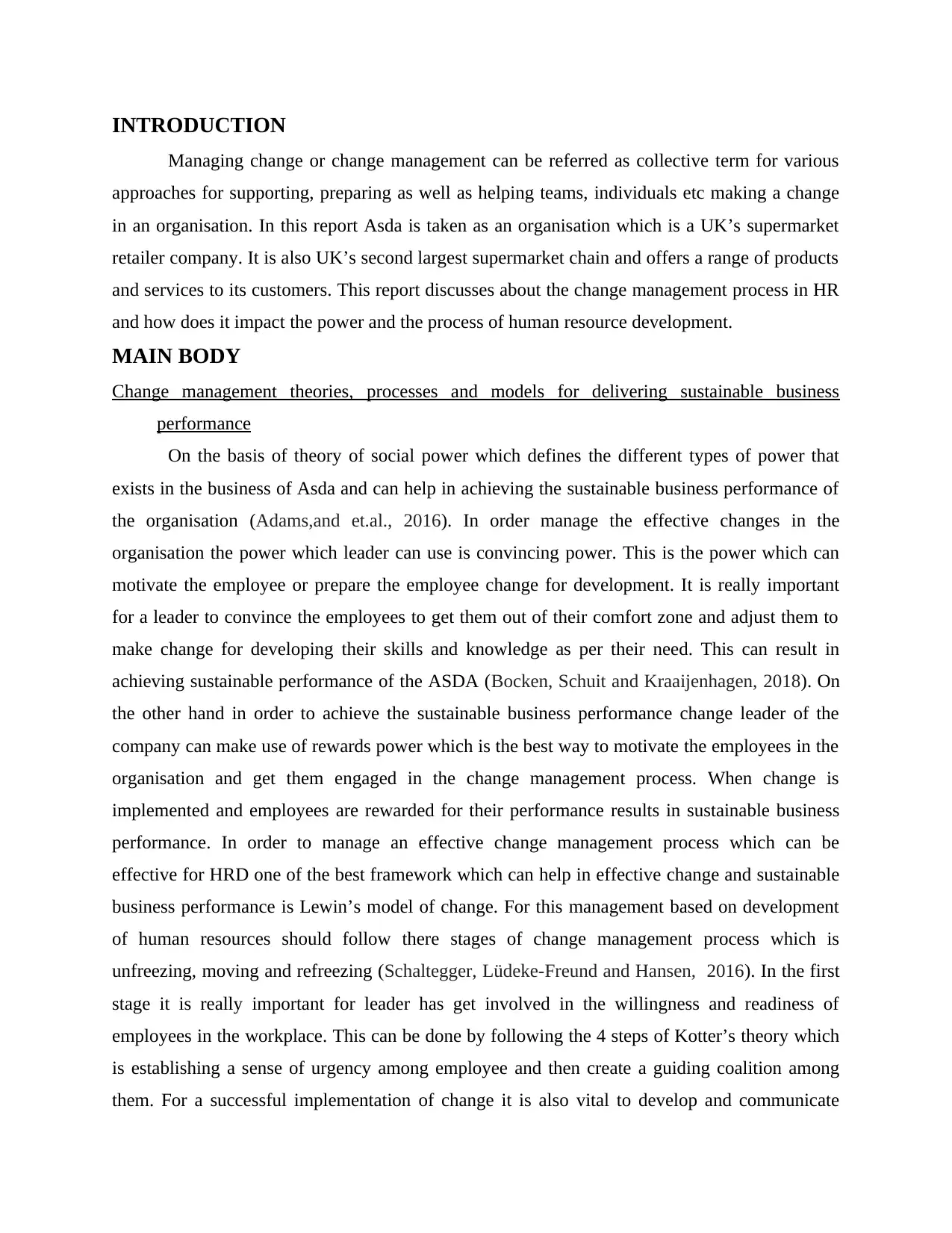
INTRODUCTION
Managing change or change management can be referred as collective term for various
approaches for supporting, preparing as well as helping teams, individuals etc making a change
in an organisation. In this report Asda is taken as an organisation which is a UK’s supermarket
retailer company. It is also UK’s second largest supermarket chain and offers a range of products
and services to its customers. This report discusses about the change management process in HR
and how does it impact the power and the process of human resource development.
MAIN BODY
Change management theories, processes and models for delivering sustainable business
performance
On the basis of theory of social power which defines the different types of power that
exists in the business of Asda and can help in achieving the sustainable business performance of
the organisation (Adams,and et.al., 2016). In order manage the effective changes in the
organisation the power which leader can use is convincing power. This is the power which can
motivate the employee or prepare the employee change for development. It is really important
for a leader to convince the employees to get them out of their comfort zone and adjust them to
make change for developing their skills and knowledge as per their need. This can result in
achieving sustainable performance of the ASDA (Bocken, Schuit and Kraaijenhagen, 2018). On
the other hand in order to achieve the sustainable business performance change leader of the
company can make use of rewards power which is the best way to motivate the employees in the
organisation and get them engaged in the change management process. When change is
implemented and employees are rewarded for their performance results in sustainable business
performance. In order to manage an effective change management process which can be
effective for HRD one of the best framework which can help in effective change and sustainable
business performance is Lewin’s model of change. For this management based on development
of human resources should follow there stages of change management process which is
unfreezing, moving and refreezing (Schaltegger, Lüdeke-Freund and Hansen, 2016). In the first
stage it is really important for leader has get involved in the willingness and readiness of
employees in the workplace. This can be done by following the 4 steps of Kotter’s theory which
is establishing a sense of urgency among employee and then create a guiding coalition among
them. For a successful implementation of change it is also vital to develop and communicate
Managing change or change management can be referred as collective term for various
approaches for supporting, preparing as well as helping teams, individuals etc making a change
in an organisation. In this report Asda is taken as an organisation which is a UK’s supermarket
retailer company. It is also UK’s second largest supermarket chain and offers a range of products
and services to its customers. This report discusses about the change management process in HR
and how does it impact the power and the process of human resource development.
MAIN BODY
Change management theories, processes and models for delivering sustainable business
performance
On the basis of theory of social power which defines the different types of power that
exists in the business of Asda and can help in achieving the sustainable business performance of
the organisation (Adams,and et.al., 2016). In order manage the effective changes in the
organisation the power which leader can use is convincing power. This is the power which can
motivate the employee or prepare the employee change for development. It is really important
for a leader to convince the employees to get them out of their comfort zone and adjust them to
make change for developing their skills and knowledge as per their need. This can result in
achieving sustainable performance of the ASDA (Bocken, Schuit and Kraaijenhagen, 2018). On
the other hand in order to achieve the sustainable business performance change leader of the
company can make use of rewards power which is the best way to motivate the employees in the
organisation and get them engaged in the change management process. When change is
implemented and employees are rewarded for their performance results in sustainable business
performance. In order to manage an effective change management process which can be
effective for HRD one of the best framework which can help in effective change and sustainable
business performance is Lewin’s model of change. For this management based on development
of human resources should follow there stages of change management process which is
unfreezing, moving and refreezing (Schaltegger, Lüdeke-Freund and Hansen, 2016). In the first
stage it is really important for leader has get involved in the willingness and readiness of
employees in the workplace. This can be done by following the 4 steps of Kotter’s theory which
is establishing a sense of urgency among employee and then create a guiding coalition among
them. For a successful implementation of change it is also vital to develop and communicate
⊘ This is a preview!⊘
Do you want full access?
Subscribe today to unlock all pages.

Trusted by 1+ million students worldwide
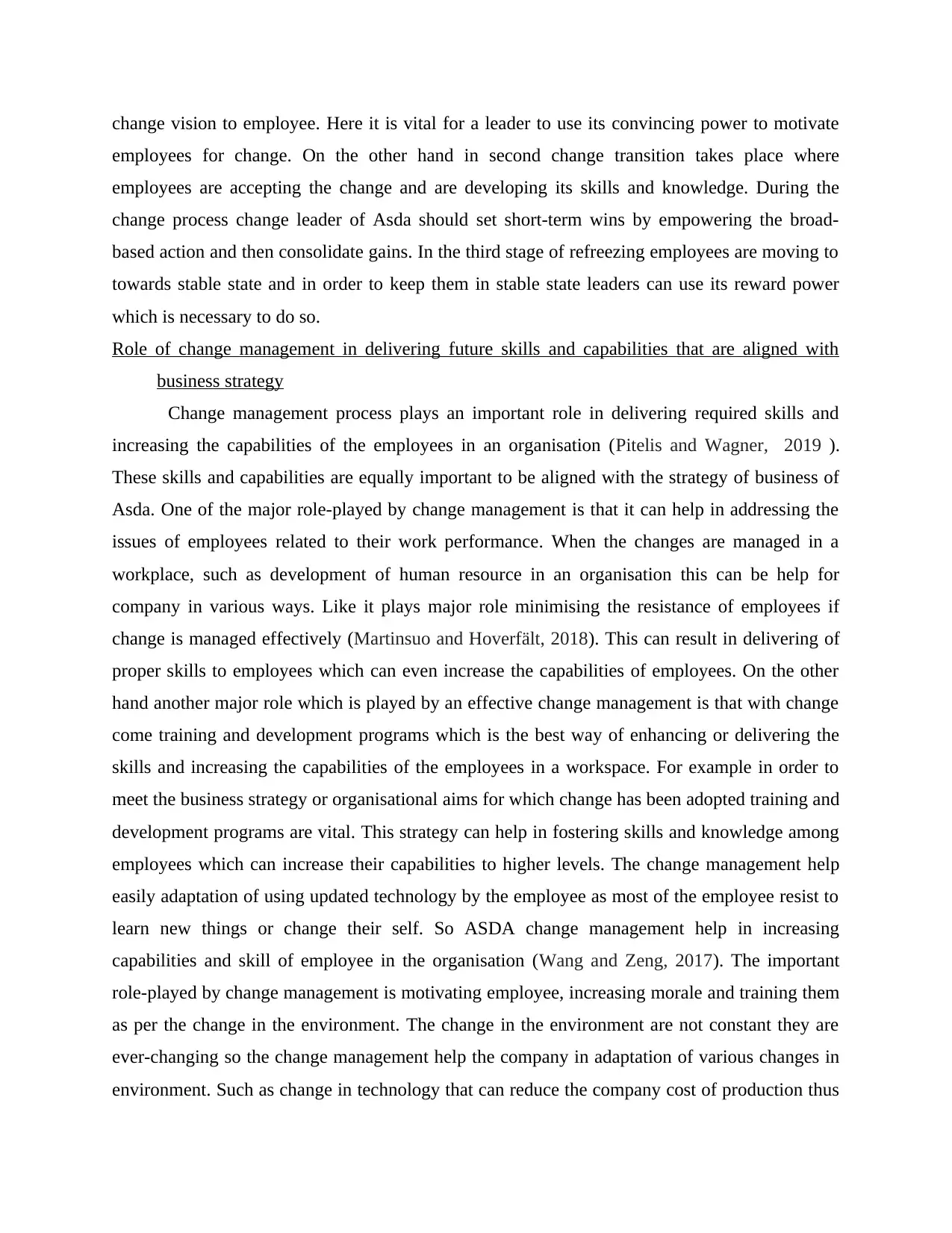
change vision to employee. Here it is vital for a leader to use its convincing power to motivate
employees for change. On the other hand in second change transition takes place where
employees are accepting the change and are developing its skills and knowledge. During the
change process change leader of Asda should set short-term wins by empowering the broad-
based action and then consolidate gains. In the third stage of refreezing employees are moving to
towards stable state and in order to keep them in stable state leaders can use its reward power
which is necessary to do so.
Role of change management in delivering future skills and capabilities that are aligned with
business strategy
Change management process plays an important role in delivering required skills and
increasing the capabilities of the employees in an organisation (Pitelis and Wagner, 2019 ).
These skills and capabilities are equally important to be aligned with the strategy of business of
Asda. One of the major role-played by change management is that it can help in addressing the
issues of employees related to their work performance. When the changes are managed in a
workplace, such as development of human resource in an organisation this can be help for
company in various ways. Like it plays major role minimising the resistance of employees if
change is managed effectively (Martinsuo and Hoverfält, 2018). This can result in delivering of
proper skills to employees which can even increase the capabilities of employees. On the other
hand another major role which is played by an effective change management is that with change
come training and development programs which is the best way of enhancing or delivering the
skills and increasing the capabilities of the employees in a workspace. For example in order to
meet the business strategy or organisational aims for which change has been adopted training and
development programs are vital. This strategy can help in fostering skills and knowledge among
employees which can increase their capabilities to higher levels. The change management help
easily adaptation of using updated technology by the employee as most of the employee resist to
learn new things or change their self. So ASDA change management help in increasing
capabilities and skill of employee in the organisation (Wang and Zeng, 2017). The important
role-played by change management is motivating employee, increasing morale and training them
as per the change in the environment. The change in the environment are not constant they are
ever-changing so the change management help the company in adaptation of various changes in
environment. Such as change in technology that can reduce the company cost of production thus
employees for change. On the other hand in second change transition takes place where
employees are accepting the change and are developing its skills and knowledge. During the
change process change leader of Asda should set short-term wins by empowering the broad-
based action and then consolidate gains. In the third stage of refreezing employees are moving to
towards stable state and in order to keep them in stable state leaders can use its reward power
which is necessary to do so.
Role of change management in delivering future skills and capabilities that are aligned with
business strategy
Change management process plays an important role in delivering required skills and
increasing the capabilities of the employees in an organisation (Pitelis and Wagner, 2019 ).
These skills and capabilities are equally important to be aligned with the strategy of business of
Asda. One of the major role-played by change management is that it can help in addressing the
issues of employees related to their work performance. When the changes are managed in a
workplace, such as development of human resource in an organisation this can be help for
company in various ways. Like it plays major role minimising the resistance of employees if
change is managed effectively (Martinsuo and Hoverfält, 2018). This can result in delivering of
proper skills to employees which can even increase the capabilities of employees. On the other
hand another major role which is played by an effective change management is that with change
come training and development programs which is the best way of enhancing or delivering the
skills and increasing the capabilities of the employees in a workspace. For example in order to
meet the business strategy or organisational aims for which change has been adopted training and
development programs are vital. This strategy can help in fostering skills and knowledge among
employees which can increase their capabilities to higher levels. The change management help
easily adaptation of using updated technology by the employee as most of the employee resist to
learn new things or change their self. So ASDA change management help in increasing
capabilities and skill of employee in the organisation (Wang and Zeng, 2017). The important
role-played by change management is motivating employee, increasing morale and training them
as per the change in the environment. The change in the environment are not constant they are
ever-changing so the change management help the company in adaptation of various changes in
environment. Such as change in technology that can reduce the company cost of production thus
Paraphrase This Document
Need a fresh take? Get an instant paraphrase of this document with our AI Paraphraser
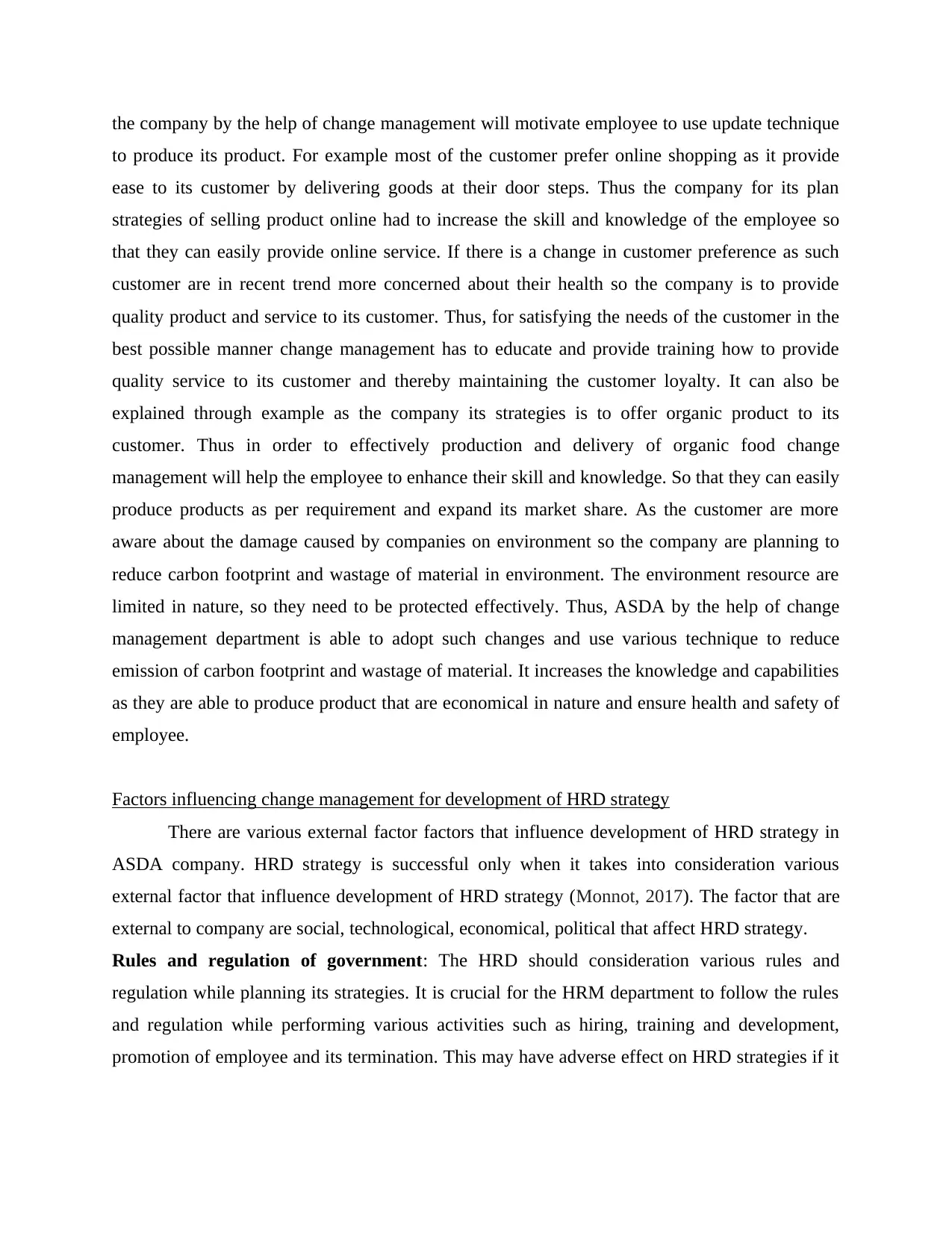
the company by the help of change management will motivate employee to use update technique
to produce its product. For example most of the customer prefer online shopping as it provide
ease to its customer by delivering goods at their door steps. Thus the company for its plan
strategies of selling product online had to increase the skill and knowledge of the employee so
that they can easily provide online service. If there is a change in customer preference as such
customer are in recent trend more concerned about their health so the company is to provide
quality product and service to its customer. Thus, for satisfying the needs of the customer in the
best possible manner change management has to educate and provide training how to provide
quality service to its customer and thereby maintaining the customer loyalty. It can also be
explained through example as the company its strategies is to offer organic product to its
customer. Thus in order to effectively production and delivery of organic food change
management will help the employee to enhance their skill and knowledge. So that they can easily
produce products as per requirement and expand its market share. As the customer are more
aware about the damage caused by companies on environment so the company are planning to
reduce carbon footprint and wastage of material in environment. The environment resource are
limited in nature, so they need to be protected effectively. Thus, ASDA by the help of change
management department is able to adopt such changes and use various technique to reduce
emission of carbon footprint and wastage of material. It increases the knowledge and capabilities
as they are able to produce product that are economical in nature and ensure health and safety of
employee.
Factors influencing change management for development of HRD strategy
There are various external factor factors that influence development of HRD strategy in
ASDA company. HRD strategy is successful only when it takes into consideration various
external factor that influence development of HRD strategy (Monnot, 2017). The factor that are
external to company are social, technological, economical, political that affect HRD strategy.
Rules and regulation of government: The HRD should consideration various rules and
regulation while planning its strategies. It is crucial for the HRM department to follow the rules
and regulation while performing various activities such as hiring, training and development,
promotion of employee and its termination. This may have adverse effect on HRD strategies if it
to produce its product. For example most of the customer prefer online shopping as it provide
ease to its customer by delivering goods at their door steps. Thus the company for its plan
strategies of selling product online had to increase the skill and knowledge of the employee so
that they can easily provide online service. If there is a change in customer preference as such
customer are in recent trend more concerned about their health so the company is to provide
quality product and service to its customer. Thus, for satisfying the needs of the customer in the
best possible manner change management has to educate and provide training how to provide
quality service to its customer and thereby maintaining the customer loyalty. It can also be
explained through example as the company its strategies is to offer organic product to its
customer. Thus in order to effectively production and delivery of organic food change
management will help the employee to enhance their skill and knowledge. So that they can easily
produce products as per requirement and expand its market share. As the customer are more
aware about the damage caused by companies on environment so the company are planning to
reduce carbon footprint and wastage of material in environment. The environment resource are
limited in nature, so they need to be protected effectively. Thus, ASDA by the help of change
management department is able to adopt such changes and use various technique to reduce
emission of carbon footprint and wastage of material. It increases the knowledge and capabilities
as they are able to produce product that are economical in nature and ensure health and safety of
employee.
Factors influencing change management for development of HRD strategy
There are various external factor factors that influence development of HRD strategy in
ASDA company. HRD strategy is successful only when it takes into consideration various
external factor that influence development of HRD strategy (Monnot, 2017). The factor that are
external to company are social, technological, economical, political that affect HRD strategy.
Rules and regulation of government: The HRD should consideration various rules and
regulation while planning its strategies. It is crucial for the HRM department to follow the rules
and regulation while performing various activities such as hiring, training and development,
promotion of employee and its termination. This may have adverse effect on HRD strategies if it
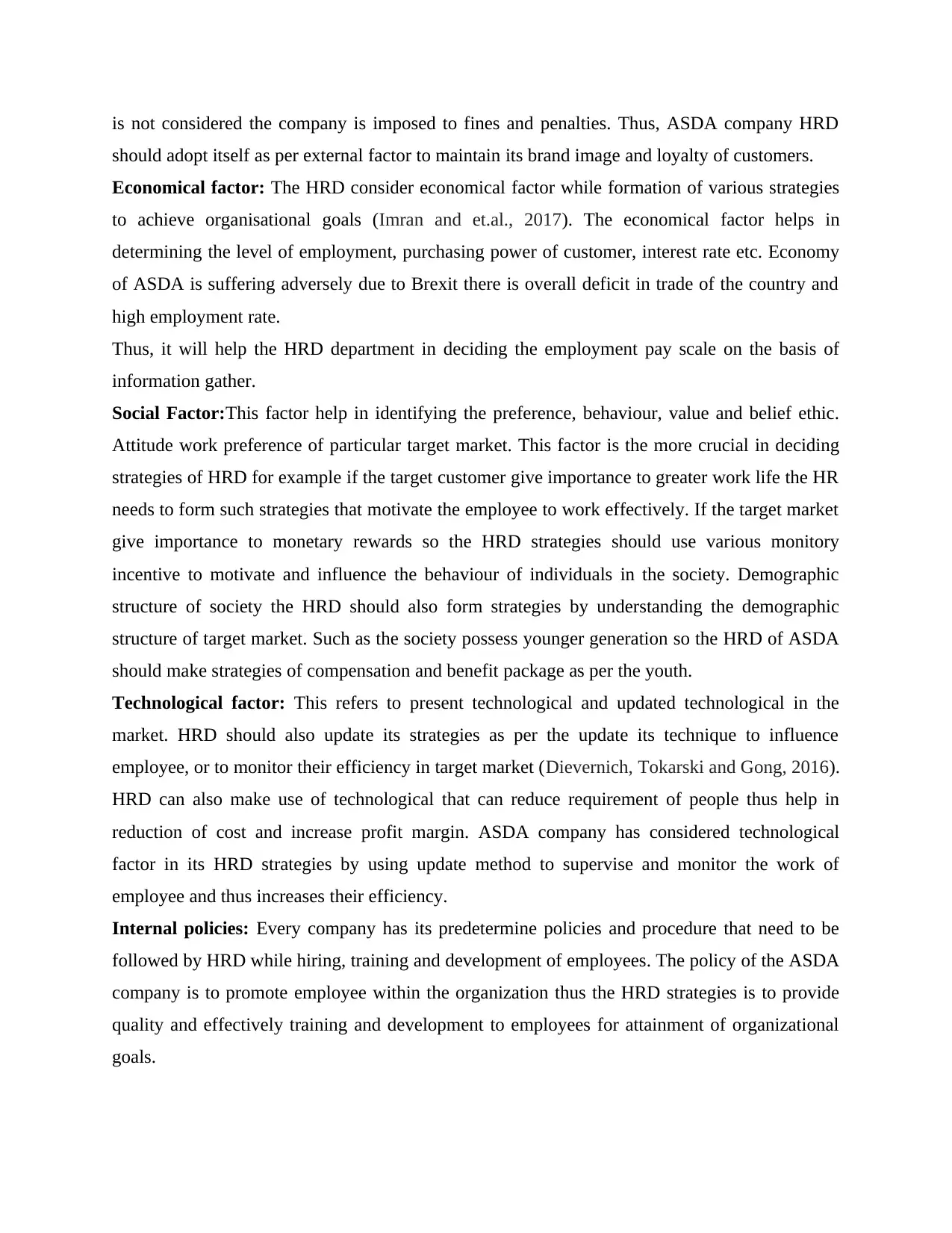
is not considered the company is imposed to fines and penalties. Thus, ASDA company HRD
should adopt itself as per external factor to maintain its brand image and loyalty of customers.
Economical factor: The HRD consider economical factor while formation of various strategies
to achieve organisational goals (Imran and et.al., 2017). The economical factor helps in
determining the level of employment, purchasing power of customer, interest rate etc. Economy
of ASDA is suffering adversely due to Brexit there is overall deficit in trade of the country and
high employment rate.
Thus, it will help the HRD department in deciding the employment pay scale on the basis of
information gather.
Social Factor:This factor help in identifying the preference, behaviour, value and belief ethic.
Attitude work preference of particular target market. This factor is the more crucial in deciding
strategies of HRD for example if the target customer give importance to greater work life the HR
needs to form such strategies that motivate the employee to work effectively. If the target market
give importance to monetary rewards so the HRD strategies should use various monitory
incentive to motivate and influence the behaviour of individuals in the society. Demographic
structure of society the HRD should also form strategies by understanding the demographic
structure of target market. Such as the society possess younger generation so the HRD of ASDA
should make strategies of compensation and benefit package as per the youth.
Technological factor: This refers to present technological and updated technological in the
market. HRD should also update its strategies as per the update its technique to influence
employee, or to monitor their efficiency in target market (Dievernich, Tokarski and Gong, 2016).
HRD can also make use of technological that can reduce requirement of people thus help in
reduction of cost and increase profit margin. ASDA company has considered technological
factor in its HRD strategies by using update method to supervise and monitor the work of
employee and thus increases their efficiency.
Internal policies: Every company has its predetermine policies and procedure that need to be
followed by HRD while hiring, training and development of employees. The policy of the ASDA
company is to promote employee within the organization thus the HRD strategies is to provide
quality and effectively training and development to employees for attainment of organizational
goals.
should adopt itself as per external factor to maintain its brand image and loyalty of customers.
Economical factor: The HRD consider economical factor while formation of various strategies
to achieve organisational goals (Imran and et.al., 2017). The economical factor helps in
determining the level of employment, purchasing power of customer, interest rate etc. Economy
of ASDA is suffering adversely due to Brexit there is overall deficit in trade of the country and
high employment rate.
Thus, it will help the HRD department in deciding the employment pay scale on the basis of
information gather.
Social Factor:This factor help in identifying the preference, behaviour, value and belief ethic.
Attitude work preference of particular target market. This factor is the more crucial in deciding
strategies of HRD for example if the target customer give importance to greater work life the HR
needs to form such strategies that motivate the employee to work effectively. If the target market
give importance to monetary rewards so the HRD strategies should use various monitory
incentive to motivate and influence the behaviour of individuals in the society. Demographic
structure of society the HRD should also form strategies by understanding the demographic
structure of target market. Such as the society possess younger generation so the HRD of ASDA
should make strategies of compensation and benefit package as per the youth.
Technological factor: This refers to present technological and updated technological in the
market. HRD should also update its strategies as per the update its technique to influence
employee, or to monitor their efficiency in target market (Dievernich, Tokarski and Gong, 2016).
HRD can also make use of technological that can reduce requirement of people thus help in
reduction of cost and increase profit margin. ASDA company has considered technological
factor in its HRD strategies by using update method to supervise and monitor the work of
employee and thus increases their efficiency.
Internal policies: Every company has its predetermine policies and procedure that need to be
followed by HRD while hiring, training and development of employees. The policy of the ASDA
company is to promote employee within the organization thus the HRD strategies is to provide
quality and effectively training and development to employees for attainment of organizational
goals.
⊘ This is a preview!⊘
Do you want full access?
Subscribe today to unlock all pages.

Trusted by 1+ million students worldwide
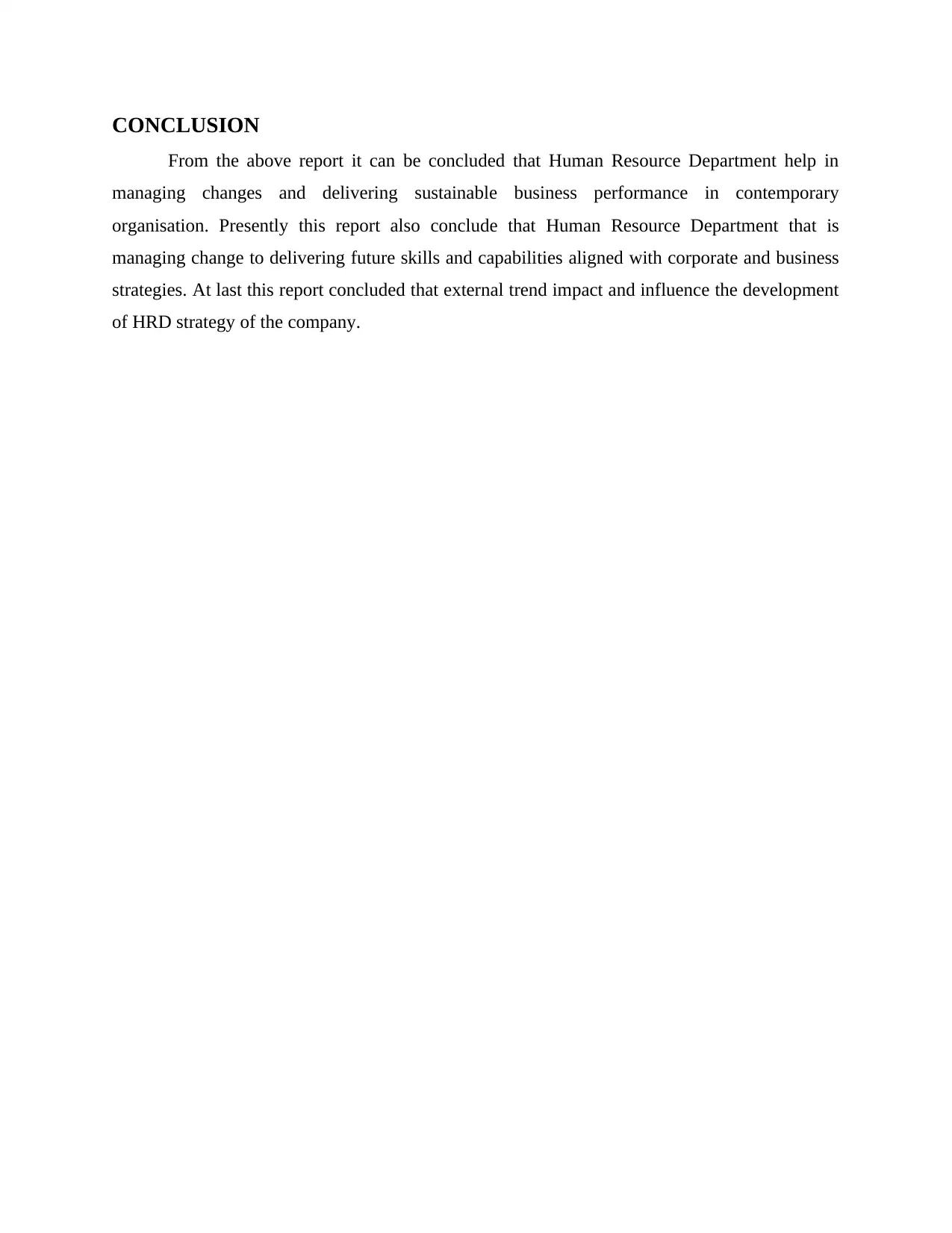
CONCLUSION
From the above report it can be concluded that Human Resource Department help in
managing changes and delivering sustainable business performance in contemporary
organisation. Presently this report also conclude that Human Resource Department that is
managing change to delivering future skills and capabilities aligned with corporate and business
strategies. At last this report concluded that external trend impact and influence the development
of HRD strategy of the company.
From the above report it can be concluded that Human Resource Department help in
managing changes and delivering sustainable business performance in contemporary
organisation. Presently this report also conclude that Human Resource Department that is
managing change to delivering future skills and capabilities aligned with corporate and business
strategies. At last this report concluded that external trend impact and influence the development
of HRD strategy of the company.
Paraphrase This Document
Need a fresh take? Get an instant paraphrase of this document with our AI Paraphraser
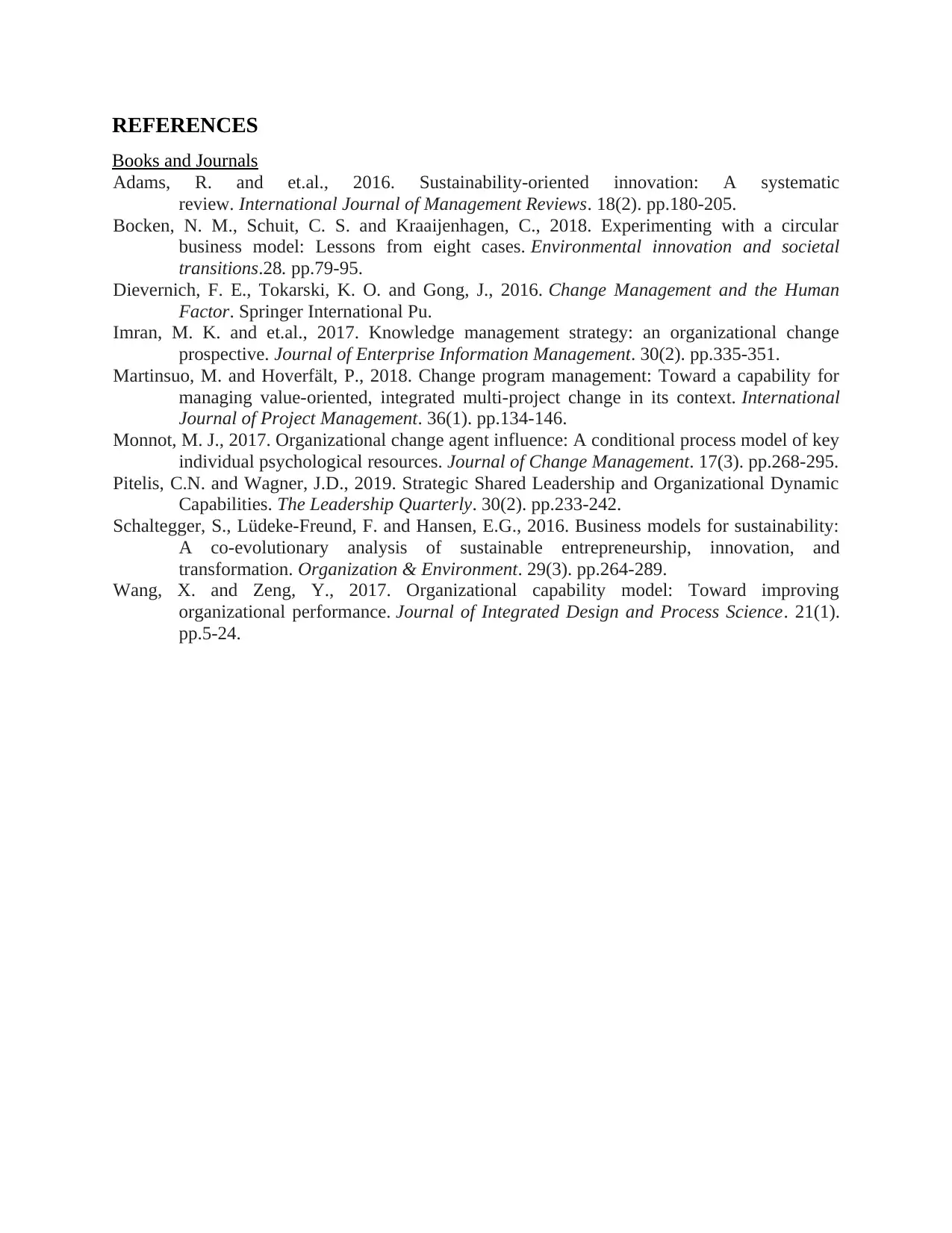
REFERENCES
Books and Journals
Adams, R. and et.al., 2016. Sustainability‐oriented innovation: A systematic
review. International Journal of Management Reviews. 18(2). pp.180-205.
Bocken, N. M., Schuit, C. S. and Kraaijenhagen, C., 2018. Experimenting with a circular
business model: Lessons from eight cases. Environmental innovation and societal
transitions.28. pp.79-95.
Dievernich, F. E., Tokarski, K. O. and Gong, J., 2016. Change Management and the Human
Factor. Springer International Pu.
Imran, M. K. and et.al., 2017. Knowledge management strategy: an organizational change
prospective. Journal of Enterprise Information Management. 30(2). pp.335-351.
Martinsuo, M. and Hoverfält, P., 2018. Change program management: Toward a capability for
managing value-oriented, integrated multi-project change in its context. International
Journal of Project Management. 36(1). pp.134-146.
Monnot, M. J., 2017. Organizational change agent influence: A conditional process model of key
individual psychological resources. Journal of Change Management. 17(3). pp.268-295.
Pitelis, C.N. and Wagner, J.D., 2019. Strategic Shared Leadership and Organizational Dynamic
Capabilities. The Leadership Quarterly. 30(2). pp.233-242.
Schaltegger, S., Lüdeke-Freund, F. and Hansen, E.G., 2016. Business models for sustainability:
A co-evolutionary analysis of sustainable entrepreneurship, innovation, and
transformation. Organization & Environment. 29(3). pp.264-289.
Wang, X. and Zeng, Y., 2017. Organizational capability model: Toward improving
organizational performance. Journal of Integrated Design and Process Science. 21(1).
pp.5-24.
Books and Journals
Adams, R. and et.al., 2016. Sustainability‐oriented innovation: A systematic
review. International Journal of Management Reviews. 18(2). pp.180-205.
Bocken, N. M., Schuit, C. S. and Kraaijenhagen, C., 2018. Experimenting with a circular
business model: Lessons from eight cases. Environmental innovation and societal
transitions.28. pp.79-95.
Dievernich, F. E., Tokarski, K. O. and Gong, J., 2016. Change Management and the Human
Factor. Springer International Pu.
Imran, M. K. and et.al., 2017. Knowledge management strategy: an organizational change
prospective. Journal of Enterprise Information Management. 30(2). pp.335-351.
Martinsuo, M. and Hoverfält, P., 2018. Change program management: Toward a capability for
managing value-oriented, integrated multi-project change in its context. International
Journal of Project Management. 36(1). pp.134-146.
Monnot, M. J., 2017. Organizational change agent influence: A conditional process model of key
individual psychological resources. Journal of Change Management. 17(3). pp.268-295.
Pitelis, C.N. and Wagner, J.D., 2019. Strategic Shared Leadership and Organizational Dynamic
Capabilities. The Leadership Quarterly. 30(2). pp.233-242.
Schaltegger, S., Lüdeke-Freund, F. and Hansen, E.G., 2016. Business models for sustainability:
A co-evolutionary analysis of sustainable entrepreneurship, innovation, and
transformation. Organization & Environment. 29(3). pp.264-289.
Wang, X. and Zeng, Y., 2017. Organizational capability model: Toward improving
organizational performance. Journal of Integrated Design and Process Science. 21(1).
pp.5-24.

⊘ This is a preview!⊘
Do you want full access?
Subscribe today to unlock all pages.

Trusted by 1+ million students worldwide

1 out of 10
Related Documents
Your All-in-One AI-Powered Toolkit for Academic Success.
+13062052269
info@desklib.com
Available 24*7 on WhatsApp / Email
![[object Object]](/_next/static/media/star-bottom.7253800d.svg)
Unlock your academic potential
Copyright © 2020–2025 A2Z Services. All Rights Reserved. Developed and managed by ZUCOL.





